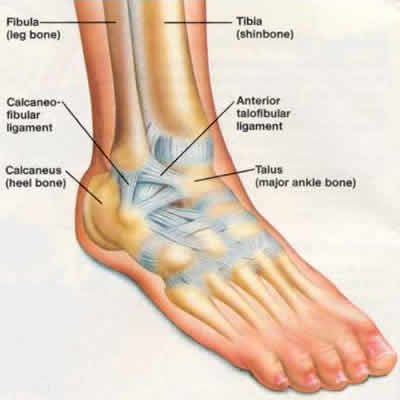ANKLE SPRAINS

DO YOU SUFFER WITH pain and swelling in one of both of your ankles?
Do you find it difficult or even impossible to walk without pain in your ankles?
Did you recently, or in the past, twist or turn your lower body as you foot remained planted on the ground?
If you answered YES to any of the questions, you probably have sprained your ankle.
You’ve twisted an ankle at some time in your life. It is a very common injury. Your ankle just ‘gave out” as you stepped on uneven ground, missed a step or got careless wearing your high heels. You find walking difficult or impossible. This means that you have stretched and possibly torn the ligaments in your ankle.
Repeated sprains can result in long-term pain and weakness in your joints. Treatment to your painful ankle can prevent ongoing ankle complaints as well as prevent compensation problems elsewhere in your body.
Remember, you body compensates for you to do the things you need to do and to get from here to there with as little pain as possible. I’ve seen patients with knee, lower back and even neck and shoulder complaints that resulted from long-standing ankle problems.
ANATOMY
The ligaments serve to hold the ankle joints together. They act as protectors against abnormal twisting, turning and rolling of the foot. Ligaments are elastic and will stretch to their limits and then return to their resting length.
When a ligament is stretched beyond its normal limit, you then have a sprain. Some elastic fibers may even tear. It is possible to break a bone in your foot or ankle at the same time that you sprained your ankle.

DO YOU HAVE THESE SYMPTOMS?
- Hearing a popping or snapping
- Immediate pain at the area of injury.
- Immediate swelling and bruising.
- Pain on movement and tenderness to the touch.
- Unable to put your weight on your foot
Ankle sprains are categorized into three grades:
- Grade 1 is a slight stretching and minimal damage with minimal tenderness and swelling.
- Grade 2 is a partial tearing of the ligament with moderate tenderness and swelling, some instability and less range of motion.
- Grade 3 is a complete tearing of the ligaments with significant tenderness and swelling and instability.
According to Gracovetsky*, two and a half TIMES your body weight ( and, ups to ten times body weight in Olympic sprinters) goes through your ankle joint with every step you take. That is a lot of force for your ankle to handle in just normal walking. Should you misstep, or in some way over-stress your foot and ankle, this causes the ligaments to stretch beyond their normal range in an abnormal position.
Ankle sprains happen most often when your foot is planted and you make sudden, shifting movement. Your ankle will either roll outwards with you foot turns inward causing the ligaments on the OUTSIDE of your ankle to over-stretch and even possibly tear.
Not so often the opposite occurs…your ankle rolls inward and your foot outward injuring the ligaments on the INSIDE of your ankle.
With a not-so-bad sprain, your ankle may swell and be stiff. You can usually walk pretty stable with little pain. A bad sprain will show bruising and be tender. Walking will be very painful and, in more severe cases, you may be unable to walk because your ankle “gives out”. You may need X-rays to rule out a broken bone in your ankle or foot.
CALL TODAY for a consultation:
Thomas Liberto, LMT, Personal Trainer
Lake Worth, FL 33460
Telephone: 561-420-3272
Email: thomas@libertotherapy.com
REFERENCES
- WebMD
- American Academy of Orthopedic Surgeons
- Dr. Craig A. Wilkes for use of the ligaments image